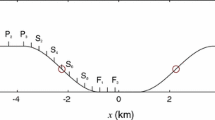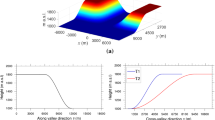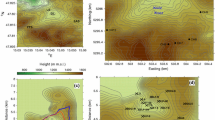Abstract
The Weather Research and Forecast numerical model is used to characterize the influence of a thermally-driven down-valley flow on a developing cold-air pool in an idealized alpine valley decoupled from the atmosphere above. Results for a three-dimensional (3D) valley, which allows for the formation of a down-valley flow, and for a two-dimensional (2D) valley, where the formation of a down-valley flow is inhibited, are analyzed and compared. A key result is that advection leads to a net cooling in the 2D valley and to a warming in the 3D valley, once the down-valley flow is fully developed. This difference stems from the suppression of the slope-flow induced upward motions over the valley centre in the 3D valley. As a result, the downslope flows develop a cross-valley circulation within the cold-air pool, the growth of the cold-air pool is reduced and the valley atmosphere is generally warmer than in the 2D valley. A quasi-steady state is reached for which the divergence of the down-valley flow along the valley is balanced by the convergence of the downslope flows at the top of the cold-air pool, with no net contribution of subsiding motions far from the slope layer. More precisely, the inflow of air at the top of the cold-air pool is found to be driven by an interplay between the return flow from the plain region and subsidence over the plateaux. Finally, the mechanisms that control the structure of the cold-air pool and its evolution are found to be independent of the valley length as soon as the quasi-steady state is reached and the down-valley flow is fully developed.
















Similar content being viewed by others
References
Baines PG (2008) Mixing in downslope flows in the ocean—plumes versus gravity currents. Atmos Ocean 46:405–419
Baker KR, Simon H, Kelly JT (2011) Challenges to modeling “cold pool” meteorology associated with high pollution episodes. Environ Sci Technol 45:7118–7119
Banta RM, Darby LS, Fast JD, Pinto JO, Whiteman CD, Shaw WJ, Orr BW (2004) Nocturnal low-level jet in a mountain basin complex. Part I: evolution and effects of local flows. J Appl Meteorol 43:1348–1365
Bou-Zeid E, Meneveau C, Parlange M (2005) A scale-dependent Lagrangian dynamic model for large eddy simulation of complex turbulent flows. Phys Fluids. doi:10.1063/1.1839152
Burns P, Chemel C (2014) Evolution of cold-air-pooling processes in complex terrain. Boundary-Layer Meteorol 150:423–447
Burns P, Chemel C (2015) Interactions between downslope flows and a developing cold-air pool. Boundary-Layer Meteorol 154:57–80
Catalano F, Cenedese A (2010) High-resolution numerical modeling of thermally driven slope winds in a valley with strong capping. J Appl Meteorol Climatol 49:1859–1880
Chemel C, Burns P (2015) Pollutant dispersion in a developing valley cold-air pool. Boundary-Layer Meteorol 154:391–408
Chen F, Dudhia J (2001) Coupling an advanced land-surface/hydrology model with the Penn State/NCAR MM5 modeling system. Part I: model implementation and sensitivity. Mon Weather Rev 129:569–585
Cuxart J (2015) When can a high-resolution simulation over complex terrain be called LES? Front Earth Sci 3:87
De Wekker SFJ, Whiteman CD (2006) On the time scale of nocturnal boundary layer cooling in valleys and basins and over plains. J Appl Meteorol Climatol 45:813–820
Dudhia J (1989) Numerical study of convection observed during the winter monsoon experiment using a mesoscale two-dimensional model. J Atmos Sci 46:3077–3107
Egger J (1990) Observations of thermally developed wind systems in mountainous terrain. In: Blumen W (ed) Atmospheric processes over complex terrain. Meteorological monographs, vol 23, no. 45. American Meteorological Society, 45 Beacon St., Boston, MA, chap 3, pp 43–58
Gudiksen PH, Shearer DL (1989) The dispersion of atmospheric tracers in nocturnal drainage flows. J Appl Meteorol 28:602–608
Holton JR (2004) An introduction to dynamic meteorology, chap 7, 4th edn. Elsevier Academic Press, Burlington, MA
Katurji M, Zhong S (2012) The influence of topography and ambient stability on the characteristic of cold-air pools: a numerical investigation. J Appl Meteorol Climatol 51:1740–1749
Klemp JB, Dudhia J, Hassiotis AD (2008) An upper gravity-wave absorbing layer for NWP applications. Mon Weather Rev 136:3987–4004
Lareau NP, Horel JD (2015) Dynamically induced displacements of a persistent cold-air pool. Boundary-Layer Meteorol 154:291–316
Largeron Y (2010) Dynamique de la couche limite atmosphérique stable en relief complexe. Application aux épisodes de pollution particulaire des vallées alpines. PhD thesis, Université de Grenoble, France
Largeron Y, Staquet C, Chemel C (2013) Characterization of oscillatory motions in the stable atmosphere of a deep valley. Boundary-Layer Meteorol 148:439–454
Łobocki L (2014) Surface-layer flux-gradient relationships over inclined terrain derived from a local equilibrium, turbulence closure model. Boundary-Layer Meteorol 150:469–483
McNider RT (1982) A note on velocity fluctuations in drainage flows. J Atmos Sci 39:1658–1660
Mlawer EJ, Taubman SJ, Brown PD, Iacono MJ, Clough SA (1997) Radiative transfer for inhomogeneous atmospheres: RRTM, a validated correlated-k model for the longwave. J Geophys Res 102:663–682
Nadeau DF, Pardyjak ER, Higgins CW, Huwald H, Parlange MB (2013) Flow during the evening transition over steep alpine slopes. Q J R Meteorol Soc 139:607–624
Neff WD, King CW (1987) Observations of complex terrain flows using acoustic sounders: experiments, topography and winds. Boundary-Layer Meteorol 40:363–392
Neff WD, King CW (1989) The accumulation and pooling of drainage flows in a large basin. J Appl Meteorol 28:518–529
O’Steen LB (2000) Numerical simulation of nocturnal drainage flows in idealized valley-tributary system. J Appl Meteorol 39:1845–1860
Pinto JO, Parsons DB, Brown WOJ, Cohn S, Chamberlain N, Morley B (2006) Coevolution of down-valley flow and the nocturnal boundary layer in complex terrain. J Appl Meteorol Climatol 45:1429–1449
Rampanelli G, Zardi D, Rotunno R (2004) Mechanism of up-valley winds. J Atmos Sci 61:3097–3111
Schmidli J, Poulos GS, Daniels MH, Chow FK (2009) External influences on nocturnal thermally driven flows in a deep valley. J Appl Meteorol Climatol 48:3–23
Schmidli J, Billings B, Chow FK, De Wekker SFJ, Doyle J, Grubišić V, Holt T, Jiang Q, Lundquist KA, Sheridan P, Vosper S, Whiteman CD, Wyszogrodzki AA, Zängl G (2011) Intercomparison of mesoscale model simulations of the daytime valley wind system. Mon Weather Rev 139:1389–1409
Schmidli J (2013) Daytime heat transfer processes over mountainous terrain. J Atmos Sci 70:4041–4066
Schmidli J, Rotunno R (2010) Mechanism of along-valley winds and heat exchange over mountainous terrain. J Atmos Sci 67:3033–3047
Schmidli J, Rotunno R (2015) The quasi-steady state of the valley wind system. Front Earth Sci 3:79
Serafin S, Zardi D (2011) Daytime development of the boundary layer over a plain and in a valley under fair weather conditions: a comparison by means of idealized numerical simulations. J Atmos Sci 68:2128–2141
Skamarock WC, Klemp JB, Dudhia J, Gill DO, Barker DM, Duda MG, Huang XY, Wang W, Powers JG (2008) A description of the advanced research WRF version 3. NCAR Technical Note NCAR/TN-475+STR, NCAR, Boulder, CO, 125 pp
Smith CM, Porté-Agel F (2014) An intercomparison of subgrid models for large-eddy simulation of katabatic flows. Q J R Meteorol Soc 140:1294–1303
Vergeiner I, Dreiseitl E (1987) Valley winds and slope winds—observations and elementary thoughts. Meteorol Atmos Phys 36:264–286
Vinokur M (1980) On one-dimensional stretching functions for finite-difference calculations. NASA contractor report 3313, NASA, Washington, DC, 56 pp
Vosper SB, Hughes JK, Lock AP, Sheridan PF, Ross AN, Jemmett-Smith B, Brown AR (2014) Cold-pool formation in a narrow valley. Q J R Meteorol Soc 140:699–714
Vosper SB, Brown AR (2008) Numerical simulations of sheltering in valleys: the formation of nighttime cold-air pools. Boundary-Layer Meteorol 127:429–448
Weigel AP, Chow FK, Rotach MW, Street RL, Xue M (2006) High-resolution large-eddy simulations of flow in a steep Alpine valley. Part II: flow structure and heat budgets. J Appl Meteorol Climatol 45:87–107
Whiteman CD (1990) Observations of thermally developed wind systems in mountainous terrain. In: Blumen W (ed) Atmospheric processes over complex terrain. Meteorological monographs, vol 23, no. 45. American Meteorological Society, 45 Beacon St., Boston, MA, chap 2, pp 5–42
Whiteman CD, Barr S (1986) Atmospheric mass transport by along-valley wind systems in a deep Colorado valley. J Clim Appl Meteor 25:1205–1212
Wicker LJ, Skamarock WC (2002) Time-splitting methods for elastic models using forward time scheme. Mon Weather Rev 130:2088–2097
Zängl G (2004) A reexamination of the valley wind system in the Alpine Inn Valley with numerical simulations. Meteorol Atmos Phys 87:241–256
Zängl G (2005) Formation of extreme cold-air pools in elevated sinkholes: an idealized numerical process study. Mon Weather Rev 133:925–941
Zardi D, Whiteman CD (2013) Diurnal mountain wind systems. In: Chow FK, De Wekker SFJ, Snyder BJ (eds) Mountain weather research and forecasting: recent progress and current challenges. Springer atmospheric sciences. Springer, New York, NY, chap 2, pp 35–119
Acknowledgments
This work has been supported by a PhD grant provided by the LabEx Osug@2020 (Investissements d’avenir – ANR10LABX56) in Grenoble and by the University of Hertfordshire. Numerical simulations were run on the French national HPC facilities at CINES. Finally, the authors thank the referees for valuable comments, which led to substantial improvements in this paper.
Author information
Authors and Affiliations
Corresponding author
Rights and permissions
About this article
Cite this article
Arduini, G., Staquet, C. & Chemel, C. Interactions Between the Nighttime Valley-Wind System and a Developing Cold-Air Pool. Boundary-Layer Meteorol 161, 49–72 (2016). https://doi.org/10.1007/s10546-016-0155-8
Received:
Accepted:
Published:
Issue Date:
DOI: https://doi.org/10.1007/s10546-016-0155-8




